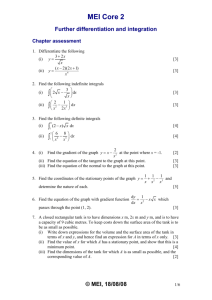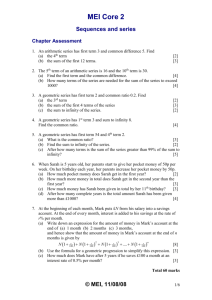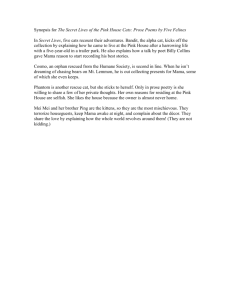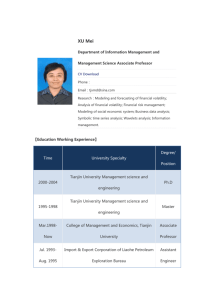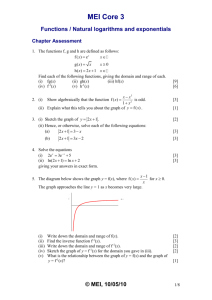Microsoft Word - M2M - Att A - PSD 1137
advertisement
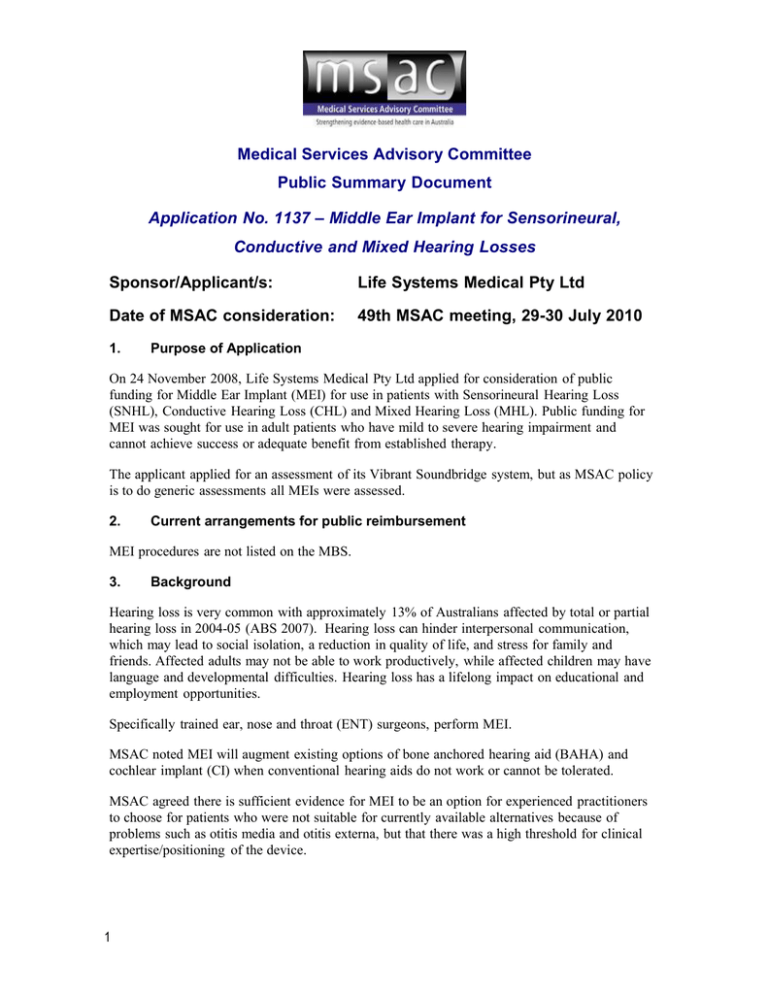
Medical Services Advisory Committee Public Summary Document Application No. 1137 – Middle Ear Implant for Sensorineural, Conductive and Mixed Hearing Losses Sponsor/Applicant/s: Life Systems Medical Pty Ltd Date of MSAC consideration: 49th MSAC meeting, 29-30 July 2010 1. Purpose of Application On 24 November 2008, Life Systems Medical Pty Ltd applied for consideration of public funding for Middle Ear Implant (MEI) for use in patients with Sensorineural Hearing Loss (SNHL), Conductive Hearing Loss (CHL) and Mixed Hearing Loss (MHL). Public funding for MEI was sought for use in adult patients who have mild to severe hearing impairment and cannot achieve success or adequate benefit from established therapy. The applicant applied for an assessment of its Vibrant Soundbridge system, but as MSAC policy is to do generic assessments all MEIs were assessed. 2. Current arrangements for public reimbursement MEI procedures are not listed on the MBS. 3. Background Hearing loss is very common with approximately 13% of Australians affected by total or partial hearing loss in 2004-05 (ABS 2007). Hearing loss can hinder interpersonal communication, which may lead to social isolation, a reduction in quality of life, and stress for family and friends. Affected adults may not be able to work productively, while affected children may have language and developmental difficulties. Hearing loss has a lifelong impact on educational and employment opportunities. Specifically trained ear, nose and throat (ENT) surgeons, perform MEI. MSAC noted MEI will augment existing options of bone anchored hearing aid (BAHA) and cochlear implant (CI) when conventional hearing aids do not work or cannot be tolerated. MSAC agreed there is sufficient evidence for MEI to be an option for experienced practitioners to choose for patients who were not suitable for currently available alternatives because of problems such as otitis media and otitis externa, but that there was a high threshold for clinical expertise/positioning of the device. 1 4. Clinical need During 2006-07 the Office of Hearing Services subsidised the fitting of 124,657 hearing aids. However, there are common problems with the devices which may lead to patients discontinuing their use, such as acoustic feedback, discomfort, ear occlusion, inadequate amplification, regular maintenance, hygiene of the ear canal and perceived social stigma. MEI was proposed for patients with mild to severe SNHL, CHL or MHL, who had failed a trial of an external hearing aid for at least three months before being considered for MEI. MEI is not proposed for people with profound hearing loss – CI is currently considered the only effective option for those with profound hearing loss. MSAC noted that the most common type of hearing loss (SNHL) is age-related. Therefore, as the Australian population ages, it is likely that the number of people suffering from hearing loss and failing an external hearing aid will increase. Otitis media is a very common childhood infection, with a higher prevalence amongst Indigenous children (4%) compared to nonIndigenous children (2%). MEI was proposed for adults with mild to severe SNHL, CNH or MHL, who had failed a trial of an external hearing aid for at least three months before being considered for MEI. MSAC noted the paucity of usage data but noted 2006-07 MBS data indicates that approximately 327 individuals with severe HL may be suitable for MEIs. MSAC also noted the possibility that some individual patients with external hearing aids who would not receive BAHA or CI may find MEI to be a more acceptable option, and so public funding of MEI may increase the numbers of patients opting to receive an implant rather than persisting with external hearing aids. 5. Comparator Table 1: Clinical comparator for MEI relative to type and severity of hearing loss INDICATIONS Mild Moderate Severe HL Sensorineural MEI vs. BAHA MEI vs. BAHA MEI vs. CI Mixed MEI vs. BAHA MEI vs. BAHA MEI vs. CI Conductive HL MEI vs. BAHA MEI vs. BAHA MEI vs. BAHA MEI is an alternative to BAHA which is well established and effective but has a number of detractions, mostly related to the need for a bone peg and maintenance of this. CI involves an additional magnitude of intervention and risk. The principal question for MSAC was how much better is MEI than BAHA in the majority of cases and severities? MSAC noted expert opinion suggest support for occasions where an individual might consider MEI over other options, but MSAC could not define any particular sub groups for this in a consistent way. In patients with mild or moderate SNHL, CHL or MHL, MSAC considered the appropriate comparator to be a BAHA. In patients with severe SNHL or MHL, MSAC considered the appropriate comparator to be a cochlear implant. In patients with severe CHL, MSAC considered the appropriate comparator to be a BAHA. 2 6. Scientific basis of comparison The sources of evidence included published literature, product and manufacturer information and patient interaction. There was no head to head scientific comparison of MEI versus BAHA or CI. Safety data are available only from case series and experience with the technique has been too short to assess effectiveness adequately. MSAC noted the technology has been in use for approximately 10 years, including in the United States and Europe, but there does not appear to have been a large uptake and the technology has not been subject to rigorous assessment. 7. Safety MSAC noted that due to the absence of comparative evidence it is not possible to accurately compare the rates of adverse events between patients receiving MEI, CI or BAHA. Case series data was used to assess the absolute safety of each device. A total of 1,222 patients were used to inform the safety of MEI. MSAC was concerned about the lack of data on the long term safety and clinical outcomes for the use of MEI, including loss of residual hearing, or in circumstances where the MEI subsequently needs to be removed and another implant used. MSAC agreed there are no long term safety data available for MEI but on the limited available evidence, MEI is likely to be at least as safe as BAHA and CI. Surgical complexity of MEI is similar to CI and greater than BAHA. CI is a more risky procedure than BAHA, and BAHA site problems are not experienced with MEI. 8. Clinical effectiveness MSAC noted there was a paucity of high level evidence with which to assess the effectiveness of the MEI. Eighteen comparative studies were available to assess the effectiveness of MEI versus the external HA. However, these conclusions are limited by the paucity of high level evidence. The lack of high quality studies may be related to the relative youth of the MEI procedure. In the absence of any comparative studies, MSAC could not be confident of the comparative effectiveness of MEI versus BAHA, and thus could not conclude that MEI is more effective than BAHA in any patient group. MSAC further noted that there was only one comparative study available to assess the effectiveness of MEI (10 patients) versus CI (123 patients). This study (Verhaegen et al., 2008) concluded that patients fitted with a Vibrant Soundbridge (VSB) or an Otologics MET (which are both MEIs) do not demonstrate better speech recognition scores than patients fitted with conventional hearing aids. However, the VSB and Otologics MET are a good option in patients with moderate to severe SNHL and external otitis media. From this nonrandomised, retrospective study, MSAC considered that MEI may be less effective than CI. The majority of the available studies assessed MEI in patients with SNHL. This is reflective of the anticipated Australian practice suggested by the clinical experts. MSAC cautioned against the very small number of studies of highly variable quality, and agreed that superior effectiveness of MEI over CI or BAHA could not be demonstrated. 3 9. Economic evaluation Due to insufficient data on comparative effectiveness to support a full cost-effectiveness analysis, a cost comparison was conducted for the different costs associated with each of the three procedures. MSAC noted there was no measure of the magnitude of clinical benefit included in the economic analysis. MSAC noted the assessment sought parity with the existing MBS item for CI. MSAC noted that substantial co-payment/out of pocket expenses would be likely for some MBS items. MSAC noted there would be major out-of-pocket expenses for in-hospital services but that these do not contribute to the Safety Net accumulations. MSAC did not agree with expert opinion and the numbers suggested in the application, that MEI would replace current CI and BAHA use, or that there would be a large pool of unmet need of those with hearing loss due to the cosmetic attraction of MEI versus BAHA, but rather noted, the selection of MEI over BAHA or CI is determined on a case-by-case basis and depends on the patient’s individual circumstances and options. MSAC noted that individuals who currently persist with hearing loss or a less than optimal hearing aid, may consider MEI implantation but would not consider BAHA or CI. Sensitivity analysis suggests that if one percent of the estimated pool of individuals with moderate or severe hearing loss elected to have MEI, the additional cost would be $2,291,787. These estimates are based on prevalence data of hearing loss in Australia and include a large proportion of older Australians for whom an MEI would not be suitable. MSAC agreed that the main reason for implantation of a MEI is not cosmetic, but rather medical reasons in subjects with chronic external otitis who cannot tolerate occlusion of the external ear canal. MSAC also accepted that some patients would ‘choose’ MEI due to greater convenience than BAHA and CI. MSAC noted the base case assumed full substitution giving a cost saving per patient of $5,878 in the current pool of patients, and that substitution of MEI for CI would be cost saving (76% of current pool have CI), whilst substitution for BAHA would be cost-increasing (24% of current pool have BAHA). Therefore, the net effect is cost saving with full substitution if MEI results in patients being at least as well off as, or better off than, after BAHA or CI. MSAC noted the outcomes depend on the type and severity of HL, and presence of therapy-resistant external otitis (or any other medical conditions that may arise out of using BAHA or CI), and would therefore influence the level of substitution across categories. However, the evidence suggests that full substitution is unlikely (low usage to date) and MEI does not appear to be superior to CI. For the pool of potential new patients, MSAC considered the cost-effectiveness of MEI for those patients who would not have had BAHA or CI but who might now have MEI (current pool: 433 total; new pool: 481). Comparing MEI with another study of CI: CI gave 2.4 times greater increase in SF-36 mental scores, for 3.3 times the cost. MSAC concluded that MEI is more expensive than BAHA, but less expensive than CI. 4 MSAC was unable to identify any particular sub group of patients who would be suitable for MEI due to failure of hearing aids and other conservative treatment. In patients for whom BAHA is suitable, MEI would be a more expensive option, but with no evidence of improved hearing to justify the extra expense. In patients for whom CI is suitable, MEI would be cheaper, but on the limited currently available evidence, may be less effective. 10. Financial/budgetary impacts MSAC estimated the first year cost of an MEI, BAHA and CI is $23,873, $15,207 and $34,466 respectively. Fee range for MEI is assumed to be the same as for CI in the economic analysis. The incremental cost of using MEI as opposed to a BAHA is $8,666 (24% of current pool have BAHA). The incremental cost saving of using an MEI as opposed to a CI is $10,593 (76% of the current pool has CI). In the base case, if patient pool receiving BAHA or CI is fully substituted with MEI then the cost saving per patient is $5,878. However, MSAC found uncertainty around the utilisation estimates, but acknowledged the applicant’s response to the final Assessment Report stressed the importance of enforcing appropriate medical indications for use of MEI. Based on 2006-07 MBS data, the total cost of BAHA would be $1,611,957 (106 patients) and the total cost of CI would be $11,270,250 (327 patients). This gives a total cost of $12,882,207. If MEI were used instead of BAHA and CI, the total cost would be $10,336,916. Hence, the cost savings of performing MEI as a direct replacement for BAHA and CI would be over $2.5 million. 11. Other significant factors If MEI were MBS listed then patients who would currently not have BAHA or CI may have MEI (new pool of patients). There is also a potential unmet need from patients who require a hearing aid but choose not to use one, and may opt for MEI. MSAC noted that the applicant had not sought approval for use of MEI in children, but noted that BAHA may present safety issues due to device loosening and the propensity for poorer site maintenance and hygiene when used in children. MSAC considered that children with hearing loss may represent a current unmet clinical need for an implant because otitis externa (which complicates or precludes the use of external hearing aids) and otitis media are very common childhood infections, and are more prevalent amongst Indigenous children compared with nonIndigenous children. The potential volume of unmet need which may be satisfied if MEI were to be listed on the MBS is unknown, and may lead to MBS “leakage”, although the complexity of the procedure is likely to act as a barrier. The current pool of patients with full substitution is 433 in total. The new pool would be around 96-481 patients (1-5% of those with moderate-severe HL and no otitis). The base case cost offset is $10.3 million for the current patient pool, but the new patient pool could add up to $11.5 million to the MBS. 5 12. Summary of consideration and rationale for MSAC’s advice MSAC discussed the assessment of middle ear implant (MEI) for use in patients with sensorineural hearing loss (SNHL), conductive hearing loss (CHL) and mixed hearing loss (MHL). In patients with mild or moderate SNHL, CHL or MHL, MSAC considered the appropriate comparator to be a bone anchored hearing aid (BAHA). In patients with severe SNHL or MHL, MSAC considered the appropriate comparator to be a cochlear implant (CI). In patients with severe CHL, MSAC considered the appropriate comparator to be a BAHA. MEI was proposed for patients with mild to severe SNHL, CHL or MHL, who had failed a trial of an external hearing aid for at least three months before being considered for MEI. MEI is not proposed for people with profound hearing loss – CI is currently considered the only effective option for those with profound hearing loss. MSAC noted that the most common type of hearing loss (SNHL) is age-related. Therefore, as the Australian population ages, it is likely that the number of people suffering from hearing loss and failing an external hearing aid will increase. MSAC noted the paucity of utilisation data by type and severity of hearing loss, but concluded that low numbers of individuals with hearing loss who would receive BAHA or CI would opt instead to receive MEI, based on current MBS services for BAHA and CI, and on assumptions about the proportion of CI used for severe (rather than profound) hearing loss. MSAC also noted the possibility that some individual patients with external hearing aids who would not receive BAHA or CI may find MEI to be a more acceptable option, and so public funding of MEI may increase the numbers of patients opting to receive an implant rather than persisting with external hearing aids. MSAC was concerned about the lack of data on the long term safety and clinical outcomes for the use of MEI, including loss of residual hearing, or in circumstances where the MEI subsequently needs to be removed and another implant used. In the absence of any comparative studies, MSAC could not be confident of the comparative effectiveness of MEI versus BAHA, and thus could not conclude that MEI is more effective than BAHA in any patient group. MSAC further noted that there was only one comparative study available to assess the effectiveness of MEI (10 patients) versus CI (123 patients). From this nonrandomised, retrospective study (NHMRC Level III), MSAC considered that MEI may be less effective than CI. Due to insufficient data on comparative effectiveness to support a full cost-effectiveness analysis, a cost comparison was conducted for the different costs associated with each of the three procedures. MSAC noted that MEI is more expensive than BAHA, but MEI is less expensive than CI. MSAC was unable to identify any particular sub group of patients who would be suitable for MEI due to failure of hearing aids and other conservative treatment. In patients for whom BAHA is suitable, MEI would be a more expensive option, but with no evidence of improved hearing to justify the extra expense. In patients for whom CI is suitable, MEI would be cheaper, but on the limited currently available evidence, may be less effective. 6 MSAC noted that the applicant had not sought approval for use of MEI in children, but noted that BAHA may present safety issues due to device loosening and the propensity for poorer site maintenance and hygiene when used in children. MSAC considered that children with hearing loss may represent a current unmet clinical need for an implant because otitis externa (which complicates or precludes the use of external hearing aids) and otitis media are very common childhood infections, and are more prevalent amongst Indigenous children compared with nonIndigenous children. Overall, MSAC found that there were insufficient clinical grounds to recommend MEI for public funding because the weak clinical evidence available did not demonstrate superiority over other options, and there are inadequate data on longer term safety. MSAC therefore rejected the application on the basis of its inability to identify particular sub groups of patients for whom listing could be justified in terms of comparative cost-effectiveness; uncertainty around long term safety, and the availability of BAHA and CI as current alternatives for all MEI indications. 13. MSAC’s advice to the Minister After considering the strength of the available evidence in relation to the safety, effectiveness and cost-effectiveness of the middle ear implant as a treatment for hearing loss, MSAC does not support public funding for middle ear implants. 14. Context for Decision This advice was made under the MSAC Terms of Reference: Advise the Minister for Health and Ageing on the strength of evidence pertaining to new and emerging medical technologies and procedures in relation to their safety, effectiveness and cost-effectiveness and under what circumstances public funding should be supported. Advise the Minister for Health and Ageing on which new medical technologies and procedures should be funded on an interim basis to allow data to be assembled to determine their safety, effectiveness and cost-effectiveness. Advise the Minister for Health and Ageing on references related either to new and/or existing medical technologies and procedures. Undertake health technology assessment work referred by the Australian Health Ministers’ Advisory Council (AHMAC) and report its findings to the AHMAC. 15. Linkages to Other Documents MSAC’s processes are detailed on the MSAC Website at: www.msac.gov.au. The MSAC Assessment Report is available http://www.msac.gov.au/internet/msac/publishing.nsf/Content/MSACCompletedAssessments1120 -1140 7
